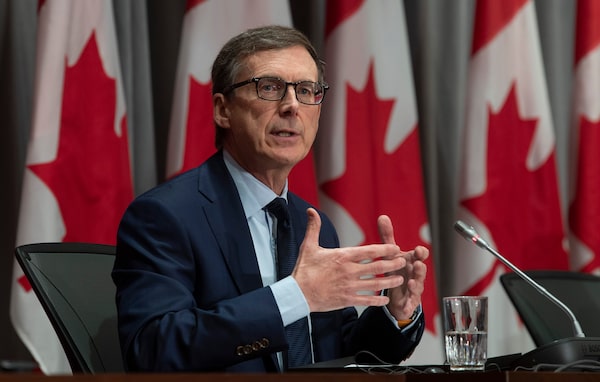
Bank of Canada Governor designate Tiff Macklem, seen here on May 1, 2020, played down the possibility of negative rates in his news conference and stressed his comfort with the current level of the central bank’s policy rate.Adrian Wyld/The Canadian Press
Tiff Macklem will spend the next seven years living in the shadow of today’s pandemic, no matter which way the Canadian economy lurches next.
If the novel coronavirus continues to throttle activity, the new governor of the Bank of Canada may have to turn to inventive new ways to stimulate the economy. The bank’s sturdiest traditional tool – lowering interest rates – is now bumping up against its limit and it has already deployed an unprecedented barrage of emergency measures.
Where could it turn next? Negative rates? Buying junk bonds? Two-tiered lending rates? All these measures are already in play elsewhere and could be on the table in Canada, too, if a recovery doesn’t materialize as expected.
But even if a rebound begins promptly, Mr. Macklem faces a demanding job. His immediate task, when he takes over the top job at the central bank on June 2, will consist of overseeing the measures unleashed over the past two months by current Governor Stephen Poloz.
The new measures include the bank’s first foray into quantitative easing, or QE, a policy in which the central bank creates money and uses it to buy government bonds.
Thanks to QE and other programs, the Bank of Canada’s balance sheet has tripled in size over the past six weeks and will continue to grow during the weeks ahead. The bank is gobbling up vast amounts of federal, provincial and investment-grade commercial debt in an attempt to ease stresses in lending markets and keep interest rates low.
Managing these programs demands a high degree of finesse. And the task will not become any easier once the pandemic is past and it is time to roll back the monetary stimulus.
“I suspect that the majority of Mr. Macklem’s seven-year term will be spent managing the unwinding of the unprecedented actions that have been required of the Bank of Canada over the past two months,” Ted Carmichael of Ted Carmichael Global Macro wrote in an e-mail.
Mr. Carmichael, a member of the C.D. Howe Institute’s monetary policy council, says the key will be to shrink the balance sheet in a way that “maximizes the likelihood of returning the economy to some semblance of normalcy without a sharp rise in inflation.”
Make no mistake: “That will be difficult,” Mr. Carmichael says.
Just how difficult is demonstrated by the struggles that global central banks have encountered as they have attempted to normalize policy after the financial crisis of a decade ago, says Karl Schamotta, chief market strategist at Cambridge Global Payments.
“Every increase in interest rates has been reversed in the face of market disruptions, and quantitative easing programs have been repeatedly wound down, only to be started up again,” he wrote in a note.
Among the specific challenges facing Mr. Macklem right now is the combined impact of both lower oil prices and pandemic lockdowns.
Collapsing commodity prices would ordinarily call for a much weaker Canadian dollar to spur export growth, but after chopping its key policy rate to a mere 0.25 per cent, the Bank of Canada has no room to cut rates further to weaken the loonie – at least, not if it wants to stay out of negative territory.
Mr. Macklem played down the possibility of negative rates in his news conference on Friday and stressed his comfort with the current level of the central bank’s policy rate.
The “disruptive effects of going negative” are hard to contain, he said. Among other things, it is difficult to explain to savers why their deposits are shrinking when they are not taking any money out.
But if the current downturn lingers longer than anticipated, Mr. Macklem could find himself revisiting the idea of negative rates, as well as other policy options, many of which are already being employed by other central banks.
The U.S. Federal Reserve, for instance, has started buying high-yield or “junk” bonds, to backstop some of the riskier areas of the credit market.
For its part, the European Central Bank is running targeted longer-term refinancing operations, or TLTRO, a two-tiered lending system in which the central bank essentially pays banks to lend to specified sectors of the economy.
In contrast, the Bank of Japan has introduced yield curve control, a policy in which it targets both short-term and long-term interest rates.
Whether Mr. Macklem actually introduces any of these policies or finds himself unwinding measures already in play will hinge on the unpredictable course of the pandemic. One way or the other, he is in for an interesting seven years.
Your time is valuable. Have the Top Business Headlines newsletter conveniently delivered to your inbox in the morning or evening. Sign up today.